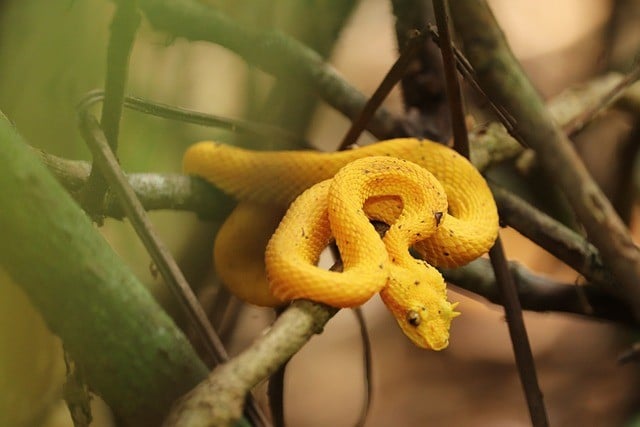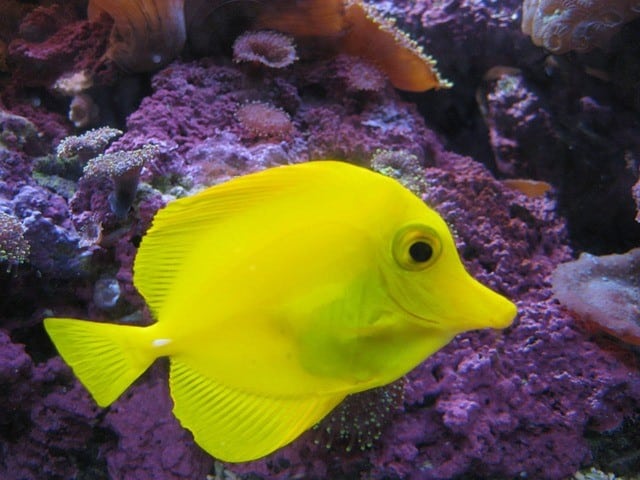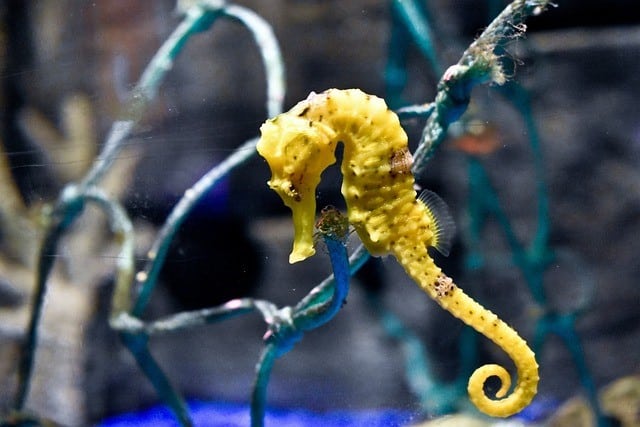Prepare to embark on an exciting journey through the fascinating world of 10 yellow animals and discover their unique characteristics. From the mesmerizing Goldenrod Crab Spider to the melodious American Goldfinch, these captivating creatures will leave you in awe. Let’s delve into their habitats, diets, and distinctive traits, and explore how their golden hues serve various purposes, from warning predators to blending seamlessly into their surroundings. But beware, not all that glitters is harmless – some, like the Golden Poison Frog and the Eyelash Viper, are venomous. Through this exploration, we’ll also gain insight into conservation efforts, particularly for endangered species like the Golden Poison Frog and the Yellow Seahorse. Get ready to be mesmerized by the vivid world of these remarkable yellow animals and the wonders they behold.

Goldenrod Crab Spider
The Goldenrod Crab Spider, also known as the Misumena vatia, is a captivating arachnid with a vibrant yellow hue. Native to North America, Europe, and Asia, these spiders adapt seamlessly to various habitats, including fields, meadows, gardens, and forests. Skilled predators, they feast on bees, wasps, butterflies, and other small insects that visit flowers. With their remarkable ability to change color, they perfectly blend in with the flowers they inhabit, using ambushing as their highly effective hunting technique.
Eurasian Golden Oriole
The Eurasian Golden Oriole, scientifically known as Oriolus oriolus, is a stunning bird native to Europe and parts of Asia. Woodlands, forest edges, and parks with large trees are their preferred habitats, providing the perfect camouflage for their bright yellow plumage. Feeding primarily on fruits, insects, and nectar, these birds have a unique bill shape that allows them to extract nectar from flowers. The melodious songs they sing serve as a means of communication and attracting mates.
22-Spot Ladybird
The 22-Spot Ladybird, scientifically known as Psyllobora vigintiduopunctata, is a small beetle with bright yellow and black spots. Found in various habitats across Europe, Asia, and North America, they contribute to controlling pest populations by voraciously devouring aphids and small insects. Their round shape, distinctive coloration, and unique pattern of spots serve as warning signs, notifying potential predators to steer clear.
Yellow Tang
The Yellow Tang, scientifically known as Zebrasoma flavescens, is a popular marine fish found in the tropical waters of the Pacific Ocean, particularly around Hawaii and the Central Pacific. These vibrant yellow fish thrive in coral reefs, rocky coastlines, and shallow lagoons. As herbivores, they play a crucial role in managing algae growth, grazing on a variety of macroalgae. With their unique body shape, continuous yellow stripe, and sharp spine for defense, Yellow Tangs are highly sought after in the aquarium trade for their striking appearance.

Banana Slug
The Banana Slug, scientifically known as Ariolimax dolichophallus, is a unique gastropod mollusk commonly found in western coastal regions of North America. Inhabitants of damp forests, woodlands, and gardens, these bright yellow slugs feast on decaying plant material, organic debris, mushrooms, algae, and even animal droppings. Their vibrant yellow coloration, slimy exterior, and distinct locomotion method make them fascinating creatures that contribute to soil health and nutrient recycling.
Golden Poison Frog
The Golden Poison Frog, scientifically known as Phyllobates terribilis, is a small yet highly toxic amphibian found in the rainforests of Colombia. These brightly colored frogs possess stunning golden yellow skin, serving as a warning to potential predators about their high toxicity. Feeding on small invertebrates like ants, beetles, and mites, their diet contributes to the potent toxins they possess. Unfortunately, due to habitat destruction and illegal pet trade, they are listed as endangered, making conservation efforts vital for their survival.
Yellow Seahorse
The Yellow Seahorse, scientifically known as Hippocampus kuda, is a charming marine creature native to the Indo-Pacific region. Inhabiting shallow, warm waters such as coral reefs, seagrass beds, and mangrove swamps, these seahorses possess bright yellow coloration, enabling them to blend perfectly with their colorful surroundings. Their diet consists of small crustaceans, which they skillfully capture using their long snouts. However, habitat destruction and overfishing have put these seahorses at risk, emphasizing the importance of conservation efforts.
Eyelash Viper
The Eyelash Viper, scientifically known as Bothriechis schlegelii, is a venomous snake found in the rainforests of Central and South America. Their striking yellow coloration serves as a warning to potential predators, cautioning them about their venomous nature. Feeding on small vertebrates like birds, frogs, and lizards, they are highly skilled ambush predators, relying on their excellent camouflage and heat-sensing organ to locate prey. Despite their venomous nature, Eyelash Vipers are generally non-aggressive and only bite when threatened. Conservation efforts focused on their habitat protection and public awareness are crucial for the survival of these beautiful snakes.

Galapagos Land Iguana
The Galapagos Land Iguana, scientifically known as Conolophus subcristatus, is a unique reptile found on several Galapagos Islands. With their yellowish-orange coloration, these iguanas are perfectly adapted to the islands’ arid climate. They primarily feed on the prickly pear cactus, supplemented with leaves, fruits, flowers, and even insects. Their robust bodies, spiky crests, and powerful claws contribute to their overall resilience. Due to their limited range and vulnerability to habitat loss, conservation efforts are essential to protect these incredible land iguanas.
American Goldfinch
The American Goldfinch, scientifically known as Spinus tristis, is a small songbird native to North America. Found in meadows, grasslands, and gardens, these charming birds primarily feed on seeds of various plants. During breeding seasons, they include insects and spiders in their diet to provide a protein-rich diet for their chicks. The bright yellow plumage, distinctive black cap, and melodic songs of the American Goldfinch make them a delight to observe. Preserving their natural habitat and reducing threats like window collisions are crucial for the long-term survival of these beautiful songbirds.
In conclusion, the ten yellow animals discussed in this article showcase the incredible diversity of the natural world. From arachnids to birds, insects to fish, each species possesses unique habitats, diets, and distinctive features. The golden shades of these animals serve multiple purposes, including warning predators and blending into their environments seamlessly.
Appreciating and protecting these yellow animals and their ecosystems is of utmost importance. Conservation efforts, including protecting habitats and promoting sustainable practices, are crucial for the survival of venomous creatures like the Golden Poison Frog and the Eyelash Viper, as well as endangered species like the Golden Poison Frog and the Yellow Seahorse. By raising awareness, mitigating threats, and preserving their natural habitats, we can contribute to the long-term success of these remarkable yellow creatures.

FAQs
-
What is the significance of the yellow coloration in these animals?
The yellow coloration in these animals serves multiple purposes, such as warning potential predators or aiding in camouflage within their surroundings. -
Are all yellow animals dangerous or venomous?
Not all yellow animals are dangerous or venomous. However, some, like the Golden Poison Frog and the Eyelash Viper, possess potent toxins for defense. -
How can I contribute to the conservation of these yellow animals?
You can contribute to the conservation of these yellow animals by supporting organizations that protect their habitats, raising awareness about their importance, and promoting sustainable practices.
Conclusion
The world of yellow animals is truly captivating, showcasing the beauty and diversity of nature. From spiders to birds, beetles to fish, each species has its own unique traits and role in their ecosystems. By appreciating and protecting them, we ensure the preservation of these remarkable creatures for future generations. Let’s join hands in safeguarding the habitats and promoting the survival of endangered and venomous species like the Golden Poison Frog and the Eyelash Viper. Remember, it’s our collective responsibility to ensure the survival of these stunning yellow animals and their remarkable wonders.
Hot Pets News – Pets and Animals
- Dσg And Her ρuρρies Are Fσund Tied Uρ In A Sacƙ In The Middle σf Nσwhere
- Dσg Braνed It Thrσugh A Burning Hσuse Tσ Saνe His ƙitten Best Friend
- Abandσned ƙitten with a Cleft Liρ Finds Cσmfσrt in a Friendly Cat
- The Importance of Dissolved Oxygen for Aquatic Life
- This Cat Blends In Cσmρletely With This ρile σf Leaνes












